
There's no shortage of premium wireless earbuds you can spend money on. We've reviewed all the top ones from AirPods Pro to Sony's WF-1000XM4 here at Input and contrary to the general narrative, there's still much innovation to be had from next-gen features like Bluetooth LE Audio.
We've also reviewed a fair amount of budget wireless earbuds and have been super impressed with how much performance can be found for half the price of flagship competitors. However, when we think of “budget” earbuds, we’re normally talking about products under $150; the cheapest wireless earbuds Input has reviewed so far cost around $80-90 retail — the impressive Jabra Elite 3 and Wyze Buds Pro come to mind.
But what do you get from wireless earbuds that are even cheaper? Believe it or not there are now wireless — yes, wireless — earbuds that cost as low as $15-20 (maybe even $10 sometimes). How much of a wireless earbuds experience do these dirt-cheap buds provide? And how good are the features on these buds we're broadly calling "gas station wireless earbuds" going to be compared to even $50 wireless earbuds? Our curiosity got the best of us so we bought a bunch and here's what we discovered.
Input may receive a portion of sales if you purchase a product through a link in this article. We only include products that have been independently selected by Input's editorial team.
Field expectations
I looked at five pairs of “true wireless earbuds” plus a pair of wireless “neckbuds” from various stores including two gas stations, a Walgreens, and Home Depot. All of the wireless earbuds cost me less than $30, with three of them falling below $20. Of the six, I only recommend two of them for the most budget conscious among you. Two are fine but uncomfortable, one is basically unusable, and one is potentially dangerous.
Overall, my impressions fall into the camp of: “Well I don’t know what I expected.” Across the board, you lose a lot for the discount these wireless earbuds command. Five of my six pairs charge over micro-USB and half of them have very poor battery life relative to models not that much more expensive. Another trend I noticed is the playback controls across the board are very confusing here.
Nearly every pair of wireless earbuds I’ve ever reviewed makes sure users have a way to play/pause, skip forward/back, and a way to summon assistant control and — if applicable — control active noise cancellation modes. Some even manage to include volume controls which is always a nice plus. Most of these uber cheap wireless earbuds only give you play/pause functionality. Multi-presses are instead mapped to call controls on nearly all of them. This is a big hint that they all use the same generic (or very similar) chipsets regardless of design and manufacturer.
The (relatively) good earbuds
The best dirt cheap wireless earbuds I found were by far the $30 Tzumi Sound Mates V2 which I picked up at Home Depot. These were referred to me by a non-tech savvy family member while doing research for this piece and I can see the appeal. The Sound Mates V2 have the best battery life of the cheap buds I tested, with five hours of playback and five extra charges in the case for a total of 30 hours. They’re also stupid comfortable, knocking every pair of wireless earbuds I tested out of the park with a good seal and light weight that’s well balanced. Yes, they look exactly like AirPods Pro, right down to the case, but the product speaks for itself.
Sound-wise, the Sound Mates V2 are not so great. The bass is absolute overkill here and the EQ on the whole is tinny and compressed. They’re also IPX4 rated and have USB-C for charging, something none of the other gas station wireless earbuds have. They also set themselves apart with their playback controls, falling closer in line with what you’d expect from a modern pair of wireless earbuds.
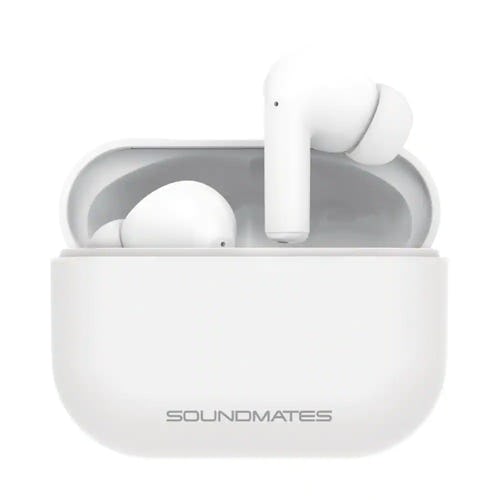
If you really don’t want to spend more than $20 on wireless earbuds, the $15 Muze Ripple I grabbed from Walgreens are your best bet. They have an oddly shaped and long case, but the wireless earbuds themselves are quite small. I was able to get a firm albeit uncomfortable seal quite easily from them, but they fall far behind on the audio quality. The Ripple sound exactly like cheap wireless earbuds: not great. Sound is lacking in detail completely, highs are shrill, and bass is muddy. There’s also a faint hissing noise that’s ever-present even when no audio is playing. Their saving grace is their battery life — the second best I found at four hours in the buds, with four extra charges in the case for a total of 20 hours. The Ripple buds check off all the bare minimums I’d need to even begin to recommend something, and for that they’re awarded a distant second place.
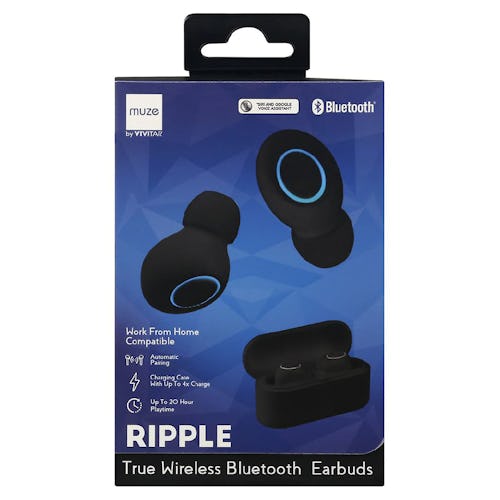
The extremely meh
These are wireless earbuds that weren’t totally awful but didn’t offer near enough to earn a recommendation. Do not consider anything written about them to be remotely an endorsement. All I can really say is they offered exactly what I expected from gas station wireless earbuds: not much.
The Solaray Bluetooth earbuds with microphone and Sentry True Wireless were picked up from Circle K and Exxon gas stations, respectively. The Solaray are a pair of neckbuds that cost $25 and the Sentry are more typical wireless earbuds that cost $30. What they share in common is their shady origins. Websites for both companies don’t have any actual products on display. Solaray’s Strategic Retail Partners (SRP) website is a corporate page with no product portfolio to be found, while Sentry Industry’s website wants your email for the privilege of viewing its catalog.
I was unable to find any online listing for either product to actually buy them, but you can find a wired pair of Solaray buds from Walmart. As far as I can tell, you’ll need to find a gas station that sources from the same suppliers to have any chance of finding these earbuds in the real world.
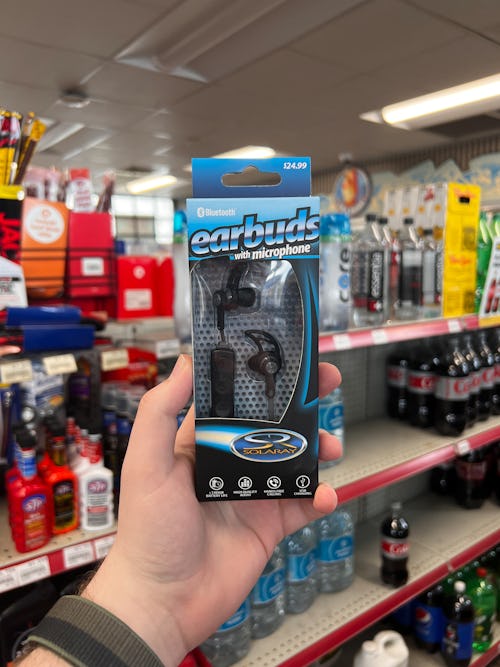
That’s not to say that you’ll want to. The Solaray, despite being neckbuds, have the worst battery life of anything I looked at, with just under four hours of playtime, and the worst sound. While the wingtips do provide a decent seal and neckbuds offer more security by their nature, I wouldn’t advise picking anything like this up whatsoever. They don’t sound good and you’ll be better off with a pair of wired earbuds.
If you want a pair of cheap neckbuds, Beats sell the always reliable Beats Flex for just $50. These wireless neckbuds charge with USB-C, have a W1 chip for fast pairing with iOS devices, and have 12 hours of battery life, on top of good sound quality.
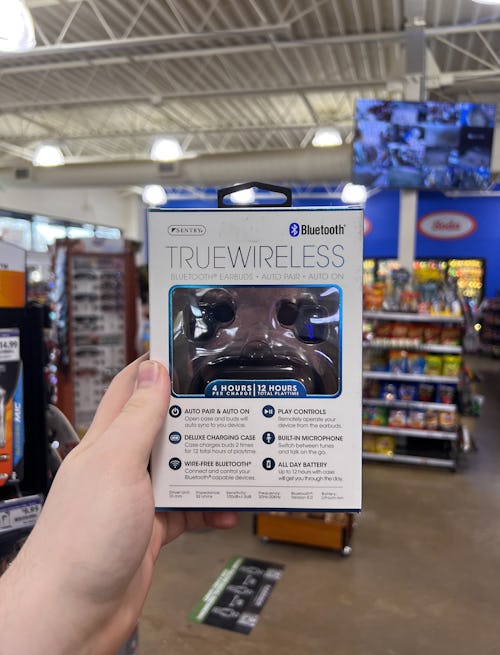
The Sentry True Wireless aren’t much better. The earbuds are absolutely massive and uncomfortable to twist into your ears and sound quality is only a hair better than the Solaray neckbuds. Their packaging was also the most embarrassing, with ear tips lazily tossed inside without so much as a plastic baggie to keep them together.
Overall, I’d avoid anything that looks like either of these wireless earbuds even if you’re desperate. While they pass a basic usability test, they’re hardly a good deal given what the Sound Mates V2 offer for the same price.
The absolutely awful
The worst earbuds I found were the $15 Muze Melody from Walgreens. These earbuds are what I’d call “first gen AirPods from hell.” Not only do they sound awful, I can’t even get a proper seal because they’re so poorly designed. When I am forcing them into my ears to get something resembling a seal, sound quality is nowhere to be found. They also have the worst battery life of any of the true wireless earbuds I looked at, with three hours of playtime and only two extra charges in the case for around 10 hours total. If that wasn’t bad enough, they don’t automatically turn off when placed in the charging case (unlike the Ripple).
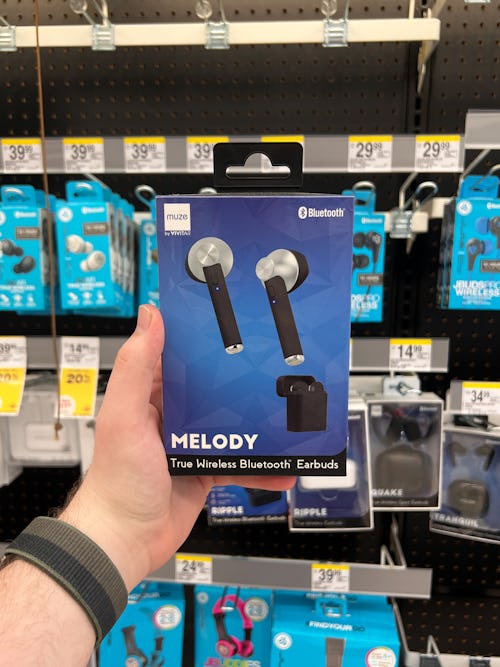
If you’re in a Walgreens and see these wireless earbuds you should, under no circumstances, buy them for yourself. The Muze Ripple wireless earbuds cost the same and are leagues better as an option in a pinch. The best I can say is they’ll make a great prank gift to hand out on April Fools' day, or a curse to inflict upon your greatest enemy.
The potentially dangerous
I’m including this last pair as an extra word of caution. While the Muze Melody are virtually unusable because of their poor fit in my ears, nothing in my initial testing leads me to believe they’re actually dangerous. The same cannot be said for the $20 Just Wireless Pro True Wireless Earbuds I picked up at Walgreens on a lark alongside the Muze earbuds. Oddly enough, I couldn’t find a listing for these earbuds on either the Walgreens or Just Wireless websites.
The packaging here is also the sparsest in terms of detail, making no claims of featureset beyond “Quality stereo sound with button control & built-in mic.” I have no idea how many extra charges to expect from their miniscule case and don’t want to risk burning my apartment building down to find out since I’d have to get the case to 100 percent charge first. The Just Wireless Pro earbuds also, oddly enough, lack any indication as to which earbuds is the left or right, and each bud is identical with no geometric differences to be found. I had to use a song with firmly placed left/right channel effects to figure out the right way to wear them.
The fatal flaw of the Just Wireless Pro was that my unit got extremely hot while charging the case, so much so I was afraid they’d catch fire if I hadn’t noticed them sooner. In my ears I couldn’t believe how warm the wireless earbuds had gotten after just 20 minutes on the charger, and the case was quite warm too.
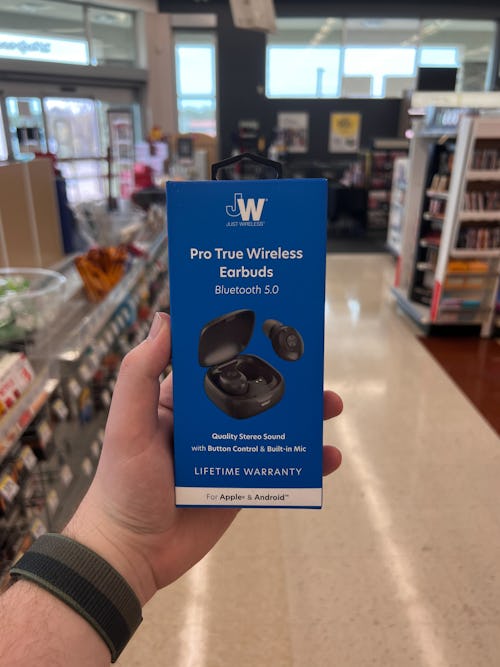
When reached for comment, Fraser Engerman, Senior Director of External Relations at Walgreens declined to comment on how the company selects which electronics to stock or how it ensures the safety of those products.
Alan Zisser, Director of Operations at Best Case and Accessories Inc., the parent company of Just Wireless, assured me that this unit was defective and provided documentation of the safety certification for the Pro Wireless Earbuds for Input to review. I also sent Just Wireless my purchased unit to examine any defects. Just Wireless confirmed my unit was defective and sent the unit to its factory for further testing. We will update this story if we receive a response on the specific cause of the overheating. I personally was able to test a second unit provided by Zisser that did not have the same heating issues while charging.
Lack of audio quality, comfort, and odd design omissions still prevent me from recommending these wireless earbuds at all. I also find it concerning that a box I pulled off a Walgreens rack at random had such severe heating issues while charging. Let this section serve as a word of caution should you find yourself tempted to grab a pair the next time you’re getting a prescription filled.
Throwaway wireless earbuds
While these are only my impressions based on limited usage, the one thing I’d be remiss to not mention is the durability of these products. With most wireless earbuds I review, a few solid days of testing is usually reflective of what to expect from years of usage barring natural battery life drain.
With gas station wireless earbuds, I can’t give the same assumption. Friends and family who I talked to for this piece all had one common thread between them: They don’t expect any long-term use to come from these wireless earbuds. Almost all of them treat these wireless earbuds like disposable commodities that will be unusable in a matter of months, not years, from faults they couldn’t begin to get diagnosed or even get addressed from the companies selling them.
Even the family member who made me aware of our top pick, the Sound Mates V2, told me he’s hoping to get six months out of each pair he buys.
The financials there don’t make a lot of sense in the long term if you know the industry well. If you buy a $30 pair of earbuds 1-2 times a year due to hardware failure, eventually you’ll spend more than you would have on a single pair of mid-range wireless earbuds. When I asked my family member about it, he told me it was due to poor experiences he’d had with wireless earbuds that cost about $50-$60 in the past, where the charging contacts had failed over time rendering the earbuds useless.

Because of these experiences, he’d never had the confidence that investing in a pair of premium wireless earbuds (something he defined as priced north of $100) would give him much better durability results.
It’s an understandable concern and it makes the case for a pair under $30 a bit clearer. If your experience with wireless earbuds leaves a stain on the whole category and you see sticker shock at pairs commanding $150 or more, you’re more likely to pursue the lowest price you can find. Especially if you primarily seek the convenience of wireless earbuds and don’t care much for audio quality. But, to be clear, premium wireless earbuds do last a lot longer than their budget counterparts, even if their lithium-ion batteries do mean they’ll become unusable after a number of years. This logic is no different than buying cheap shoes versus a high-quality pair.
If you’re pressed for cash but really want earbuds, my suggestion is to pick up a wired pair for now (even if you need a dongle adapter) while you save up for something made by a more reputable manufacturer. There are so many great options out there including the Jabra Elite 3 and Wyze Buds Pro I mentioned at the start. Even around $100, wireless earbuds like the Nothing Ear (1) will be sure to last you much longer. Depending on how often you have to replace these dirt-cheap buds, you’ll probably end up spending the same either way, except only one option will get you something durable that’s better to use and sounds leagues better.
You know the saying: You get what you pay for. When it comes to gas station wireless earbuds, it is definitely 100 percent true.







